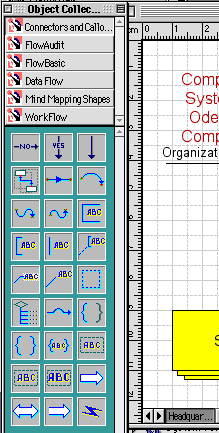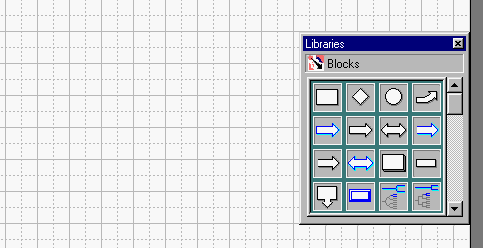The Open dialog will come up and show the Libraries folder.
ConceptDraw offers you a number of ready-made objects which you can use in your
documents. They are grouped in topical sets as library files. A library
is thus a collection of objects usually related to a certain topic (e.g. flow
chart, computer network, engineering, etc.).
The Professional version of the software provides over 25
additional libraries (930 new objects) for such areas as:
In ConceptDraw, you can also customize the existing libraries and create new ones (both by grouping the existing objects and by adding new ones).
Using Libraries
Editing and Creating Libraries
Opening and Closing Libraries
Library Files Allocation
Library Window
Inserting a Library Object into a Document
Stamp Tool
Opening and Closing Libraries
To open one or more libraries:
![]() Both libraries and document can be
opened by dragging their file icons from Explorer or My Computer
windows, and dropping them onto the application window. In this case you have to drag the
file icon, position it over the respective taskbar button, wait until the application
window opens, and then release the mouse button over the toolbar or over the library
window. As you release the button, the mouse pointer must look like this:
Both libraries and document can be
opened by dragging their file icons from Explorer or My Computer
windows, and dropping them onto the application window. In this case you have to drag the
file icon, position it over the respective taskbar button, wait until the application
window opens, and then release the mouse button over the toolbar or over the library
window. As you release the button, the mouse pointer must look like this: ![]()
![]() Both libraries and documents can be
opened by dragging their file icons over the application icon.
Both libraries and documents can be
opened by dragging their file icons over the application icon.
Note: Re-opening a currently opened library will just make it active, not duplicate it.
To close a library, get its context menu (on the tab
with its title) and select the Close command.
To close all the open libraries, choose Close All
from the context menu.
You can also use the Library menu: the Close command for closing the active library, and the Close All command to close the library window with all the libraries it contains.
Library Files Allocation
All the libraries supplied are located in the Libraries folder of the application's root directory. The Libraries folder contains task-related subfolders. The library files themselves (.cdl files for Windows) are located in these folders.
The path to the Libraries folder is stored in the Preferences
dialog (Edit / Preferences) on the File Paths tab. It is
completed by default, and this path determines which folder should be initially opened by
the Open Library command.
So if you move the Libraries folder to another location, specify it on the File
Paths tab: it will be easier to find the libraries every time you need them.
If you create your own libraries, you may store the new library files in any location. But it is better to create task-related subfolders inside the Libraries folder, and place your library files there. It will be easier to find all the libraries in one location.
Library Window
All the open libraries are displayed in the special Library window. It usually appears to the left from the document windows.

The library window displays the content of the active library, and holds the tabs with the titles of all the open libraries. The tab of the currently active library is shown as selected. To activate any library from the list, just click on the corresponding tab. Only one library at a time can be active.
The objects of all the libraries can be displayed in two ways: in the form of icons
or text.
In the text view, just the names of the library objects are displayed in a list.
In the icon view, you can pause the pointer over an object to see a tip with its
name. The object's name also appears in the status bar. The selected object shows a red
border around its icon.
To change the view of the objects, get the context menu
of a library tab (or of any object) and select the suitable option: View as Icon
or View as Text.
These commands are also available from the Library / Object menu.
You can show / hide the library window easily: just press the F4 key or check/uncheck Libraries in the View menu.
You can reposition the library window if necessary:
![]() In the Mac
version, just drag the library window by its headline or by the space between the icons,
In the Mac
version, just drag the library window by its headline or by the space between the icons,
and drop in the needed location.
![]() In the Windows
version, the library window can be glued to either side of the application window, or just
be in floating state. To glue / detach the library window,
double-click on its title. Once the window is detached, you can move it by
dragging to whatever location. If dropped on the application window sides, it will be
glued automatically.
In the Windows
version, the library window can be glued to either side of the application window, or just
be in floating state. To glue / detach the library window,
double-click on its title. Once the window is detached, you can move it by
dragging to whatever location. If dropped on the application window sides, it will be
glued automatically.
Another way is to drag the library window by the space between
the icons or by the bar which frames the object list and separates it from the library
title tabs and the scroll bars.
Note: The state and position of the library window are preserved when you quit the application.
Inserting a Library Object into a Document
There are several ways for inserting a library object into your document:
a) By dragging and dropping:
Select the needed library object and drag it from the library window to the document page.
Release the mouse button where you want a copy of the object to be inserted.
b) By double-clicking the object:
If you double-click an object in the library window, its copy will be inserted in the
centre of the active document page.
c) By copying and pasting:
Use the Copy command from the object's context menu or from the Library
/ Object menu.
The copy of the object will be placed on the Clipboard. Then, in the document window, call
the context menu again and use the Paste command. The contents
of the Clipboard will be inserted in the position of the pointer. (This way lets you
insert several copies of the objects in different locations).
Stamp Tool
The Stamp Tool ![]() mode lets use a library as a set of drawing tools.
mode lets use a library as a set of drawing tools.
You can also use the Tools / Stamp menu to switch to this mode.

If there is a library object selected, and the Stamp mode is on, every single click in the document will insert a copy of the object (stamp it).
You can resize the object at the same time as you create it. Just drag the mouse to draw a rectangular area of the desired size, and release the mouse button. In fact, you copy the library object and resize it at the same time. For proportional resizing, hold down the Shift key.
The Stamp Tool is most convenient way to quickly link objects using library connectors. If there is a 1D object (connector) selected in the library, you can attach it to objects straight away, as you do with regular connectors. To invert the direction of the connector, hold down the Shift key.
When in the Stamp mode, all the regular operations (such as selecting, repositioning, resizing) are also available.
Note: If there is no object selected in the library, this tool will clone the selected object(s) in the document. If several objects are selected, their copies will be grouped automatically. In this case, immediate resizing is also possible.
See also:
Editing and Creating Libraries